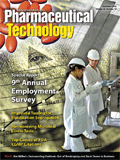The Harmonization of the Microbial Limits Tests
The US Pharmacopeia (USP), the Japanese Pharmacopoeia, and the European Pharmacopoeia "Microbial Limits Tests" are in the final stages of harmonization. The harmonized USP chapters are slated for implementation in 2009. This article describes the harmonized USP Chapters <61> "Microbial Enumeration," <62> "Absence of Specified Microorganisms," and <1111> "Microbiological Attributes of Nonsterile Pharmaceutical Products," and suggests they will likely require some revalidation of existing methodologies. Companies should put plans in place immediately for this work and show consistent progress towards this goal.
The US Pharmacopeia (USP) and the European Pharmacopoeia (Pharm Eur) "Microbial Limits Tests" are in the final stages of harmonization. They were signed off to Stage 6A at the November 2005 meeting of the Pharmacopeial Discussion Group held in Chicago, Illinois (1), and the harmonized versions have been published (see USP 2006, supplement 2). The harmonized chapters (Stage 6B, see sidebar, "Stages of the Pharmacopeial Discussion Group process") do not differ significantly from the drafts published in 2003 (2–4).

PHOTOS.COM
The format of the USP chapters changes dramatically with this harmonization. Whereas the Microbial Limits Tests were two chapters in the USP 29 (5, 6), they are now modified in the harmonized version to mirror the European format (see Table I).
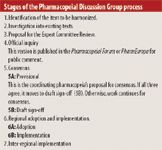
Stages of the Pharmacopeial Discussion Group process
The implementation of the tests is on different schedules in the United States and in Europe. In the United States, the tests were originally scheduled to become effective Aug. 1, 2007, but the implementation date has been postponed to May 1, 2009 on the basis of comments received by USP. In Europe, implementation has three different schedules depending upon the situation:
1. Substances covered by a monograph specification: use the methods of the European Pharmacopoeia (A) until the monograph is revised and implemented (projected date: January 2009).
2. Substances not covered by a monograph specification: use either the methods of the European Pharmacopoeia (A) or the harmonised methods (B) until January 2010. From January 2010: use harmonised methods (B).
3. Preparations: use either method of the European Pharmacopoeia (A) or the harmonised method (B) of chapter 5.1.4 until January 2010. For new preparations, use of harmonised method (B) is advisable. From January 2010: Use harmonised method (B) of chapter 5.1.4 (7).
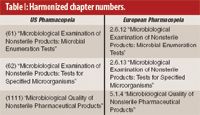
Table I: Harmonized chapter numbers.
USP ‹61› "Microbial Enumeration"
The microbial enumeration test is a basic, simple design to count the number of colony-forming units (CFUs) in a nonsterile product or raw material. The preferred method is to put the material into a solution and then plate the aliquots to determine the CFUs/g (or mL) of initial material. If the product cannot be put into a solution, the most probable number (MPN) method has several provisions to use. A full description of the MPN method is outside the scope of this article, but interested readers can refer to the discussion in the US Food and Drug Administration's Bacterial Analytical Manual (8).
The method of plating can be either pour plate, spread plate, or material filtration and then placing the membrane filter on an agar plate surface. The membrane filtration method should only be used when few CFUs are expected to be found in the material to be tested. Though membrane filtration is a good method to test a large volume of liquid, it can only count as many as 100 CFUs/membrane.
The harmonized method provides much more detail than any of the current pharmacopeial methods in terms of demonstrating method suitability (method validation) and media-growth promotion.
The demonstration of method suitability should be performed using the challenge organisms listed (see Tables IIa–b) in accordance with the recommendations found in USP Chapter ‹1227› (9). Growth promotion is an area of some ambiguity in the compendial text. Although media-growth promotion is not described in the tests, it is required. USP Chapter ‹1117› (10) provides assistance in designing the studies using 10–100 CFUs of the challenge organisms.

Table IIa: Aspects of the current and harmonized microbial limits tests (enumeration).
A major concern of many quality control workers is whether the changes in the harmonized chapter will necessitate the revalidation of existing assays to meet harmonized test requirements. Several considerations might lead to revalidation: a required change in media, in the volume of material required for testing, or in general testing conditions. It is difficult to determine whether all product types would require revalidation, and thus a summary table (see Tables IIa–b) is included in this article to describe the critical aspects of the current "Microbial Limits Tests (Enumeration)" and the draft harmonization text. This table is provided only as an aid. The decision of whether or not revalidation is necessary rests with each individual facility for its particular products.

Table IIb: Aspects of the current and harmonized microbial limits tests (enumeration).
USP ‹62› "Absence of Specified Microorganisms"
There is a significant controversy in the United States over the intent of this evaluation. FDA is bound by the concern expressed in the Code of Federal Regulations (21 CFR 211.113 and 21 CFR 211.165) relating to the importance of "objectionable microorganisms." This issue is addressed in the final section of this review because the harmonized Chapter ‹1111› deals with "other organisms."
Tables IIIa–c presents the existing "Microbial Limits—Absence of Specified Microorganisms" tests from the current USP and Pharm Eur, as well as the harmonized document. It is presented as an aid to evaluation, and may assist in determining whether revalidation of method suitability studies is needed. It should be noted that this harmonized chapter represents a true compromise by all parties, with (at least in the author's opinion) significant changes from the current USP, Pharm Eur, and JP chapters. Table IV provides guidance about the media-growth promotion expectations of the new chapters.
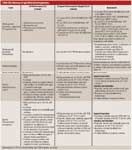
Table IIIa: Absence of specified microorganisms.
As the reader reviews these sections, it is reasonable to consider the current validation (or microbial recovery or method suitability) studies performed for currently marketed products. It is very likely that many of these studies may need to be performed again to meet the expectations of the harmonized procedure.
USP ‹1111› "Microbial Quality": a new compendial consideration of "other organisms"
Chapter ‹1111› "Microbial Examination of Nonsterile Products: Acceptance Criteria for Pharmaceutical Preparations and Substances for Pharmaceutical Use" is a relatively short section that has a significant impact. For the US reader, the allowance for twice the specification in observed results is significant. But, this is not the major change.
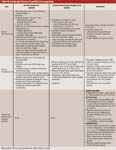
Table IIIb: Absence of specified microorganisms.
Before the introduction of the harmonized Chapter ‹1111›, USP was only interested in specified organisms. These organisms are specified in monographs. But, FDA has been concerned about objectionable organisms. The "Control of Microbiological Contamination (a)" section of 21 CFR 211.113 states, "Appropriate written procedures, designed to prevent objectionable microorganisms on drug products not required to be sterile, shall be established and followed." This is reinforced by 21 CFR 211.165 which states in the section "Testing and release for distribution... (b) There shall be appropriate laboratory testing, as necessary, of each batch of drug product required to be free of objectionable microorganisms."
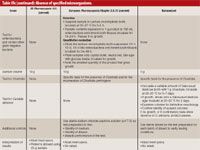
Table IIIc: Absence of specified microorganisms.
Thus, industry has had a problem. The USP monograph for a product (as provided in the current National Formulary [NF]) may require the "Absence of Pseudomonas aeruginosa." A test in the "Microbial Limits" chapter demonstrates the absence of P. aeruginosa. Although this test may be needed to demonstrate compliance with the monograph requirements laid out in the National Formulary, it does not meet FDA's concern that all microorganisms in a nonsterile product should be acceptable to the product and the target population (i.e., are not "objectionable").

Table IV: Nutritive, selective, and indicative properties of media.
The FDA concern
If a company's product approval to market submission states it will test the finished product by the "Microbial Limits Tests," FDA will enforce the good manufacturing practices (GMPs) requirement that it must do so. This is purely a GMP concern. Nonetheless, the agency has been absolutely clear about its concern over objectionable microorganisms in the product and that testing to the USP chapter might be necessary, but it is not sufficient to demonstrate acceptable microbial quality. In fact, in the 1993 instructional guide for inspections of quality-control microbiology laboratories (11), FDA points out several issues that have occurred by particular contaminants of nonsterile medicines that compromised patient health. The document notes that the USP provides methods for specific organisms, but not all objectionable organisms and FDA strongly recommends all organisms be identified to determine which are acceptable and which are objectionable. This section of the guidance concludes:
The importance of identifying all isolates from either or both Total Plate Count testing and enrichment testing will depend upon the product and its intended use. Obviously, if an oral solid dosage form such as a tablet is tested, it may be acceptable to identify isolates when testing shows high levels. However, for other products such as topicals, inhalants or nasal solutions where there is a major concern for microbiological contamination, isolates from plate counts, as well as enrichment testing, should be identified.
Why is microbial contamination of concern? To understand, we must consider the history on this matter. As early as 1942, USP had a test for the "Bacteriological Examination of Gelatin" (12). But, most nonsterile medications in the United States were not required to assay for microbiological quality attributes until the introduction of the "Microbial Limits Tests" in 1970 (13). In the late 1960s, several outbreaks of disease were traced back to pathogen-contaminated medications, which prompted increased attention to the microbial content of nonsterile drugs (14). Later in the 1980s, a series of articles described contamination by P. cepacia (currently Burkholderia cepacia) (15, 16) and its survival in disinfectants (17–21). This concern led to the addition of requirements in the 21 CFR to ensure that no objectionable organisms are in product released to market.
The compendial concern
As early as 1982, the USP is on record for verifying that the demonstration of "absence of objectionable microorganisms" is not the intent of the chapter. In a one-page Stimuli to the Revision Process (22), the microbiology committee of the time states:
The tests described in the Microbial Limits Tests ‹61› were not designed to be all-inclusive, i.e., to detect all potential pathogens. To accomplish this, an extensive text on laboratory detection of microorganisms would be required. The procedures in USP were designed to detect the presence of specific "index" or "indicator" organisms. Nevertheless, the present chapter does not preclude the detection of Ps. Cepacia - the organism requires subsequent differentiation. The chapter does not provide specific methods for this, nor does it provide procedures for detecting thousands of other potentially pathogenic organisms. Individual monographs include requirements for limits on total aerobic counts and/or absence of one or more of the four selected "indicator" organisms. The chapter on Microbial Limits Tests provides methods to assure that one may test for those microbial requirements in the individual monographs.
Against this background, we now examine the short harmonized Chapter ‹1111›, which consists of two tables and a few paragraphs. A significant passage in this chapter reads:
In addition to the microorganisms listed in Table I [Table I is entitled "Acceptance Criteria for Microbiological Quality of Nonsterile Dosage Forms"], the significance of other microorganisms recovered should be evaluated in terms of the following:
- The use of the product: hazard varies according to the route of administration (eye, nose, respiratory tract).
- The nature of the product: does the product support growth? does it have adequate antimicrobial preservation?
- The method of application.
- The intended recipient: risk may differ for neonates, infants, the debilitated.
- Use of immunosuppressive agents, corticosteroids.
- The presence of disease, wounds, organ damage.
Where warranted, a risk-based assessment of the relevant factors is conducted by personnel with specialized training in microbiology and in the interpretation of microbiological data. For raw materials, the assessment takes account of the processing to which the product is subjected, the current technology of testing, and the availability of materials of the desired quality.
The harmonized chapter does not provide instruction beyond this level, but do not overlook this "new" recommendation. Merely showing the absence of specified organisms is not sufficient to demonstrate the microbial quality of a nonsterile product.
Conclusions
The US Pharmacopeia and the US Food and Drug Administration are in agreement about the question of the microbial quality of nonsterile pharmaceuticals: the product must be safe for use. The internationally harmonized chapters provide a strong framework for this assurance.
The introduction of these three harmonized chapters is likely to require some revalidation of existing methodologies. Companies should put plans in place immediately for this work and show consistent progress toward this goal.
The National Formulary monograph requirements for the absence of specific organisms is a minimal requirement and should not be taken as proof that the product is suitable for sale from a microbiological perspective. Harmonized Chapter ‹1111› recommends the determination of the risk associated with "other organisms," which is in agreement with the FDA expectation for absence of "objectionable" organisms. The manufacturer is responsible for the quality and safety of the product marketed, and it is FDA's clear expectation (as described in CFR) that this will include a determination of the microbial safety (i.e., the "absence of objectionable microorganisms") from the product. These positions have been publicly stated for decades and should not come as a surprise. The harmonized microbial limits tests only address the "absence of specified microorganisms" and leave the determination of the "absence of objectionable microorganisms" in the capable hands of each company's appropriately educated and well-trained microbiology group.
Scott Sutton, PhD, is a consultant with emphasis on microbiology and GMP issues at Vectech Pharmaceutical Consultants, Inc., tel. 585.594.8273, scott.sutton@microbiol.org He also operates the PMFList, a microbiology e-mail list (http://www.microbiol.org/pmflist.htm) and the PSDG e-mail list (pharmaceutical stability topics).
Submitted: Aug. 30, 2006. Accepted: Sept. 26, 2006.
Keywords: European Pharmacopoeia, Japanese Pharmacopoeia,limits, microbial testing, US Pharmacopeia,
References
1. USP Chapter ‹1196›, "Pharmacopeial Harmonization," US Pharmacopeia (USP) 29–National Formulary (NF) 24 (US Pharmacopeial Convention [USP], Rockville, MD, 2006), pp. 3031–3035.
2. USP, Chapter ‹61›, "Microbiological Examination Of Nonsterile Products: Microbial Enumeration Tests," Pharm Forum. 29 (5), 1714–1722 (2003).
3. USP, Chapter ‹62›, "Microbiological Examination of Nonsterile Products: Tests for Specified Microorganisms," Pharm Forum. 29 (5), 1722–1733 (2003).
4. USP, Chapter ‹1111›, "Microbiological Quality of Nonsterile Pharmaceutical Products," Pharm Forum. 29 (5), 1733–1735 (2003).
5. Chapter ‹61›, "Microbial Limits Tests," USP 29–NF 24 (US Pharmacopeial Convention, Rockville, MD, 2006), pp. 2503–2508.
6. Chapter ‹1111›, "Microbiological Attributes of Nonsterile Pharmaceutical Products," USP 29–NF 24 (USP, Rockville, MD, 2006), p. 2969.
7. European Directorate for the Quality of Medicines, http://www.pheur.org/site/page_630.php?rubrique=446, accessed Oct. 23, 2006.
8. US Food and Drug Administration, Bacterial Analytical Manual Online, http://www.cfsan.fda.gov/~ebam/bam-toc.html. The second appendix with tutorial on most probable number methods: http://www.cfsan.fda.gov/~ebam/bam-a2.html, accessed Oct. 20, 2006.
9. Chapter ‹1227›, "Validation of Microbial Recovery from Pharmacopeial Articles," USP 29–NF 24 (USP, Rockville, MD, 2006), pp. 3053–3055.
10. USP, Chapter ‹1117›, "Microbiological Best Laboratory Practices," Pharm Forum. 30 (5), 1713–1721 (2004).
11. US Food and Drug Administration, "Guide to Inspections of Microbiological Pharmaceutical Quality Control Laboratories," www.fda.gov/ora/inspect_ref/igs/micro.html, accessed Oct. 20, 2006.
12. Chapter "Bacteriological Examination of Gelatin," USP XII (USP, Rockville, MD, 1942), pp. 556–559.
13. Chapter, "Microbial Limit Tests," USP XVIII (USP, Rockville, MD, 1970), p. 846.
14. J. Price, "Establishing Microbiological Specifications for Pharmaceuticals Not Required to Be Sterile," Pharm. Mfg. (April) 26–29 (1984).
15 . R.J. Kuhn et al., "Bacterial Contamination of Aerosol Solutions Used To Treat Cystic Fibrosis," Amer. J. Hosp. Pharm. 39 308–309 (1982).
16. L.A. Carson et al., "Morphological, Biochemical and Growth Characteristics of Pseudomonas cepacia from Distilled Water," Appl. Microbiol. 25 (3), 476–483 (1973).
17. S.G. Geftic et al., "Fourteen-Year Survival of Pseudomonas cepacia In a Salts Solution Preserved with Benzalkonium Chloride," Appl. Microbiol. 37 (3), 505–510 (1979).
18. R.L. Anderson et al., "Prolonged Survival of a Strain of Pseudomonas cepacia in a Commercially Manufactured Povidone-Iodine," Appl. Environ. Microbiol. 56 3598 (1990).
19. W.B.Hugo et al., "Factors Contributing to the Survival of a Strain of Pseudomonas cepacia In Chlorhexidine Solutions," Lett. Appl. Microbiol. 2, 37–42 (1982).
20. G.E. Borovian, "Pseudomonas cepacia: Growth In and Adaptability to Increased Preservative Concentrations," J. Soc. Cosmet. Chem. 34 197–203 (1983).
21. R.M.E. Richards et al., "Pseudomonas cepacia Resistance to Antibacterials," J. Pharm. Sci. 68 1436–1438 (1979).
22. USP, "Microbial Contamination of Sterile and Non-Sterile Articles, with Special Reference to Pseudomonas cepacia," Pharm. Forum. 8 (4), 2239 (1982).
